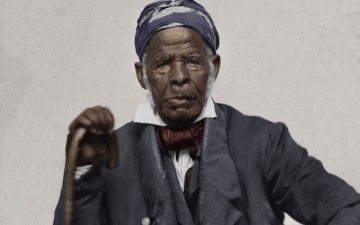Sam Haselby in aeon:
 The first words to pass between Europeans and Americans (one-sided and confusing as they must have been) were in the sacred language of Islam. Christopher Columbus had hoped to sail to Asia and had prepared to communicate at its great courts in one of the major languages of Eurasian commerce. So when Columbus’s interpreter, a Spanish Jew, spoke to the Taíno of Hispaniola, he did so in Arabic. Not just the language of Islam, but the religion itself likely arrived in America in 1492, more than 20 years before Martin Luther nailed his theses to the door, igniting the Protestant reformation. Moors – African and Arab Muslims – had conquered much of the Iberian peninsula in 711, establishing a Muslim culture that lasted nearly eight centuries. By early 1492, the Spanish monarchs Ferdinand and Isabella completed the Reconquista, defeating the last of the Muslim kingdoms, Granada. By the end of the century, the Inquisition, which had begun a century earlier, had coerced between 300,000 and 800,000 Muslims (and probably at least 70,000 Jews) to convert to Christianity. Spanish Catholics often suspected these Moriscos or conversos of practising Islam (or Judaism) in secret, and the Inquisition pursued and persecuted them. Some, almost certainly, sailed in Columbus’s crew, carrying Islam in their hearts and minds.
The first words to pass between Europeans and Americans (one-sided and confusing as they must have been) were in the sacred language of Islam. Christopher Columbus had hoped to sail to Asia and had prepared to communicate at its great courts in one of the major languages of Eurasian commerce. So when Columbus’s interpreter, a Spanish Jew, spoke to the Taíno of Hispaniola, he did so in Arabic. Not just the language of Islam, but the religion itself likely arrived in America in 1492, more than 20 years before Martin Luther nailed his theses to the door, igniting the Protestant reformation. Moors – African and Arab Muslims – had conquered much of the Iberian peninsula in 711, establishing a Muslim culture that lasted nearly eight centuries. By early 1492, the Spanish monarchs Ferdinand and Isabella completed the Reconquista, defeating the last of the Muslim kingdoms, Granada. By the end of the century, the Inquisition, which had begun a century earlier, had coerced between 300,000 and 800,000 Muslims (and probably at least 70,000 Jews) to convert to Christianity. Spanish Catholics often suspected these Moriscos or conversos of practising Islam (or Judaism) in secret, and the Inquisition pursued and persecuted them. Some, almost certainly, sailed in Columbus’s crew, carrying Islam in their hearts and minds.
Eight centuries of Muslim rule left a deep cultural legacy on Spain, one evident in clear and sometimes surprising ways during the Spanish conquest of the Americas. Bernal Díaz del Castillo, the chronicler of Hernán Cortés’s conquest of Meso-America, admired the costumes of native women dancers by writing ‘muy bien vestidas a su manera y que parecían moriscas’, or ‘very well-dressed in their own way, and seemed like Moorish women’. The Spanish routinely used ‘mezquita’ (Spanish for mosque) to refer to Native American religious sites. Travelling through Anahuac (today’s Texas and Mexico), Cortés reported that he saw more than 400 mosques.
Islam served as a kind of blueprint or algorithm for the Spanish in the New World. As they encountered people and things new to them, they turned to Islam to try to understand what they were seeing, what was happening. Even the name ‘California’ might have some Arabic lineage. The Spanish gave the name, in 1535, taking it from The Deeds of Esplandian (1510), a romance novel popular with the conquistadores. The novel features a rich island – California – ruled by black Amazonians and their queen Calafia. The Deeds of Esplandian had been published in Seville, a city that had for centuries been part of the Umayyad caliphate (caliph, Calafia, California).
More here.
